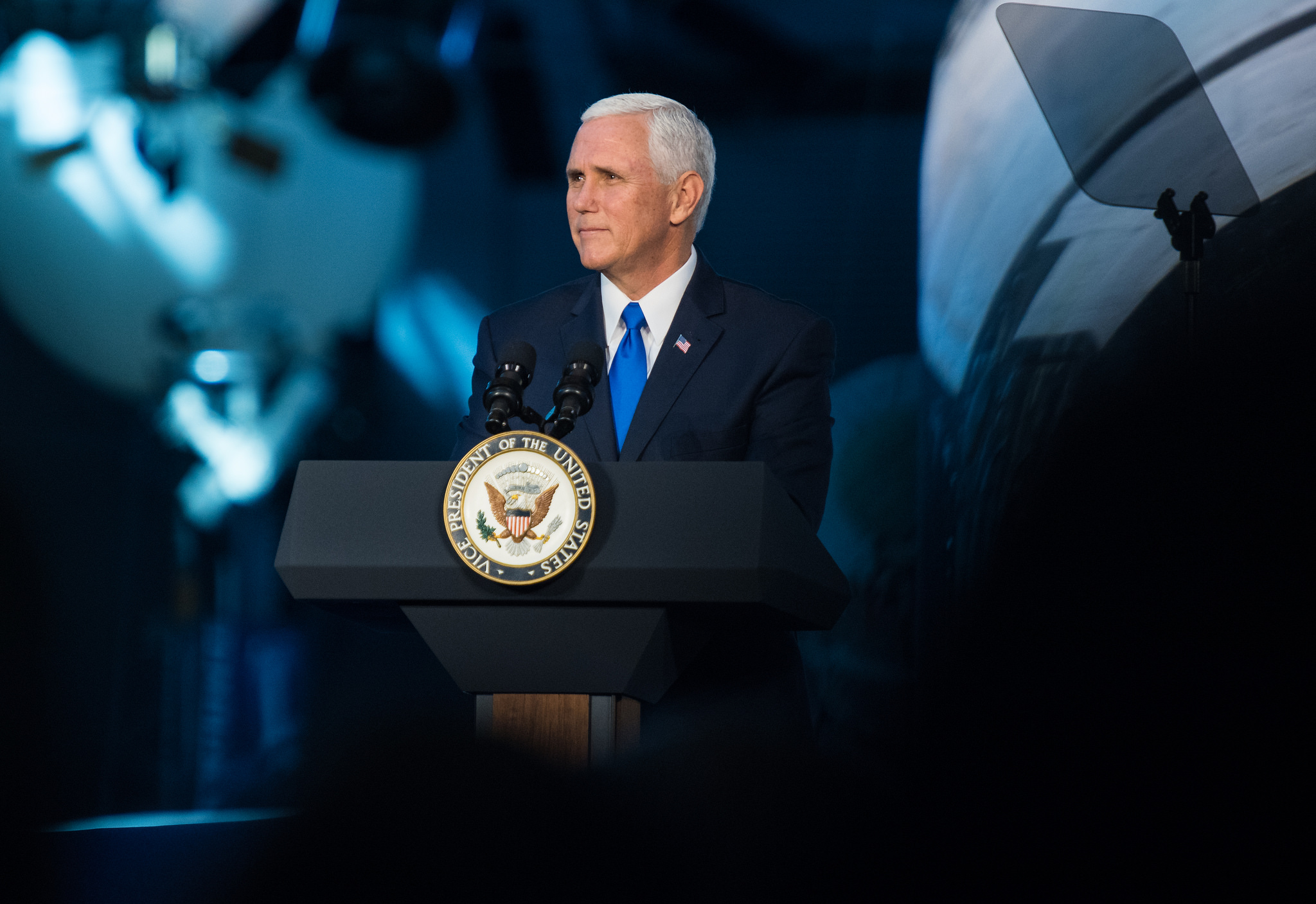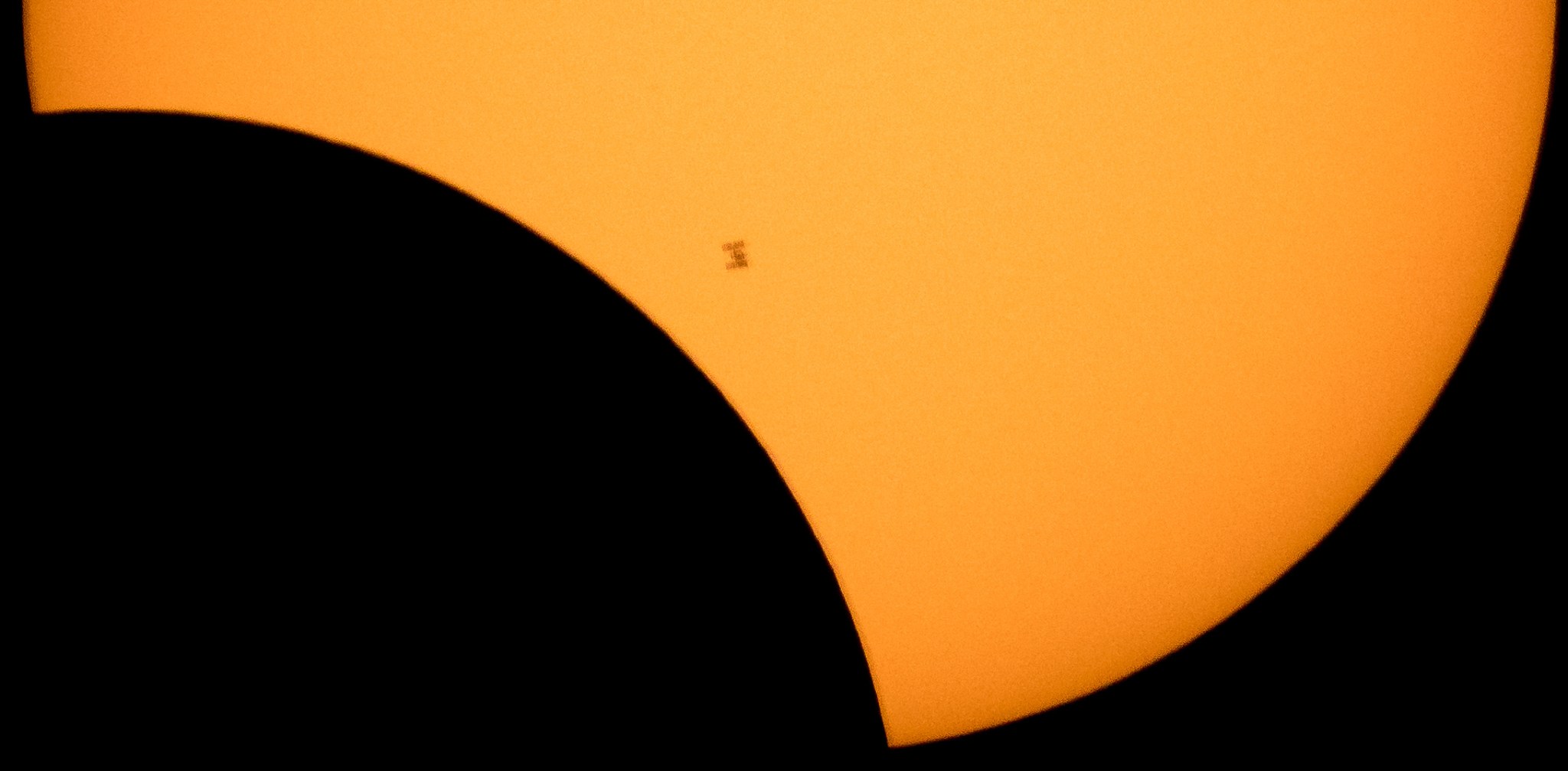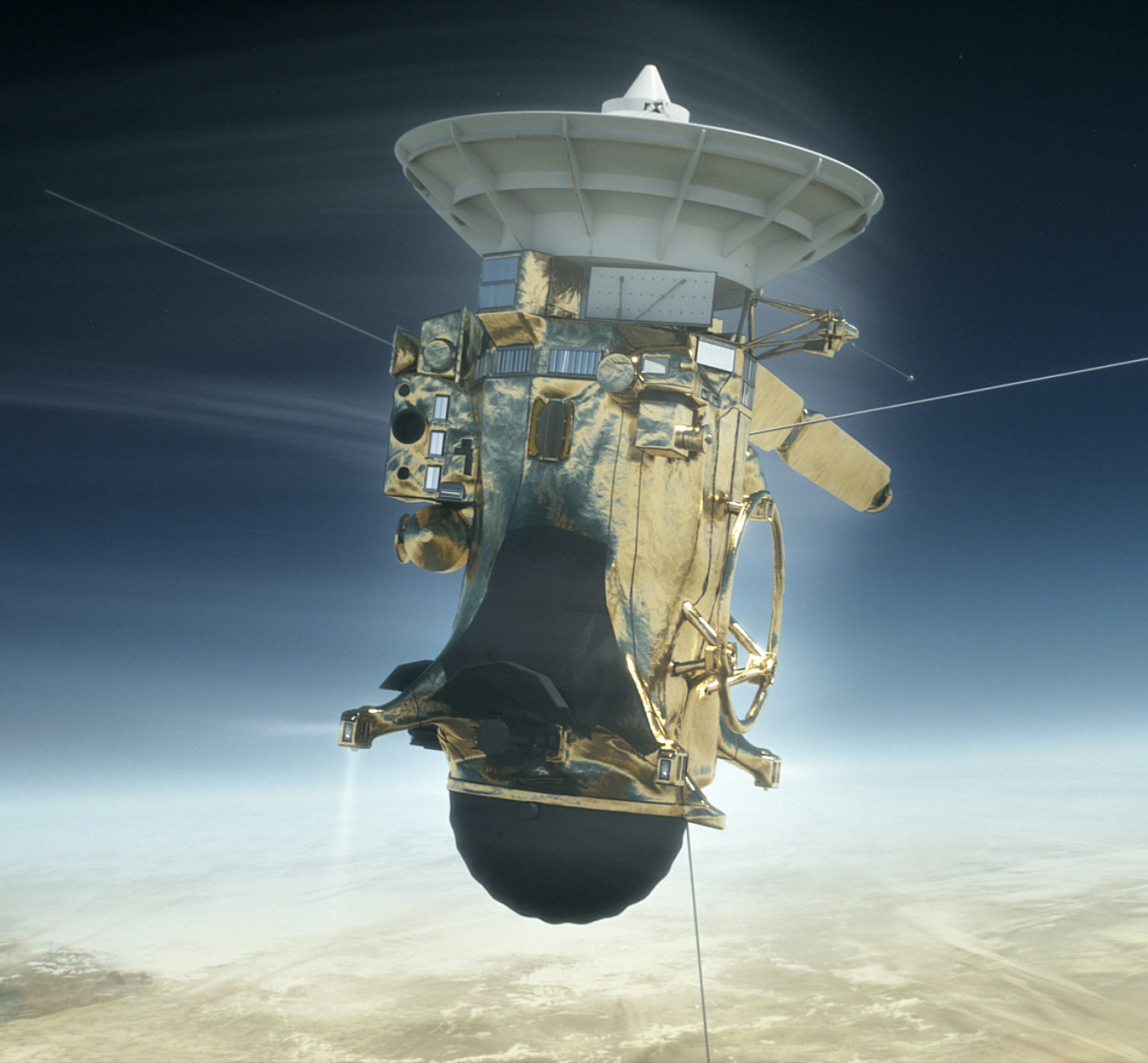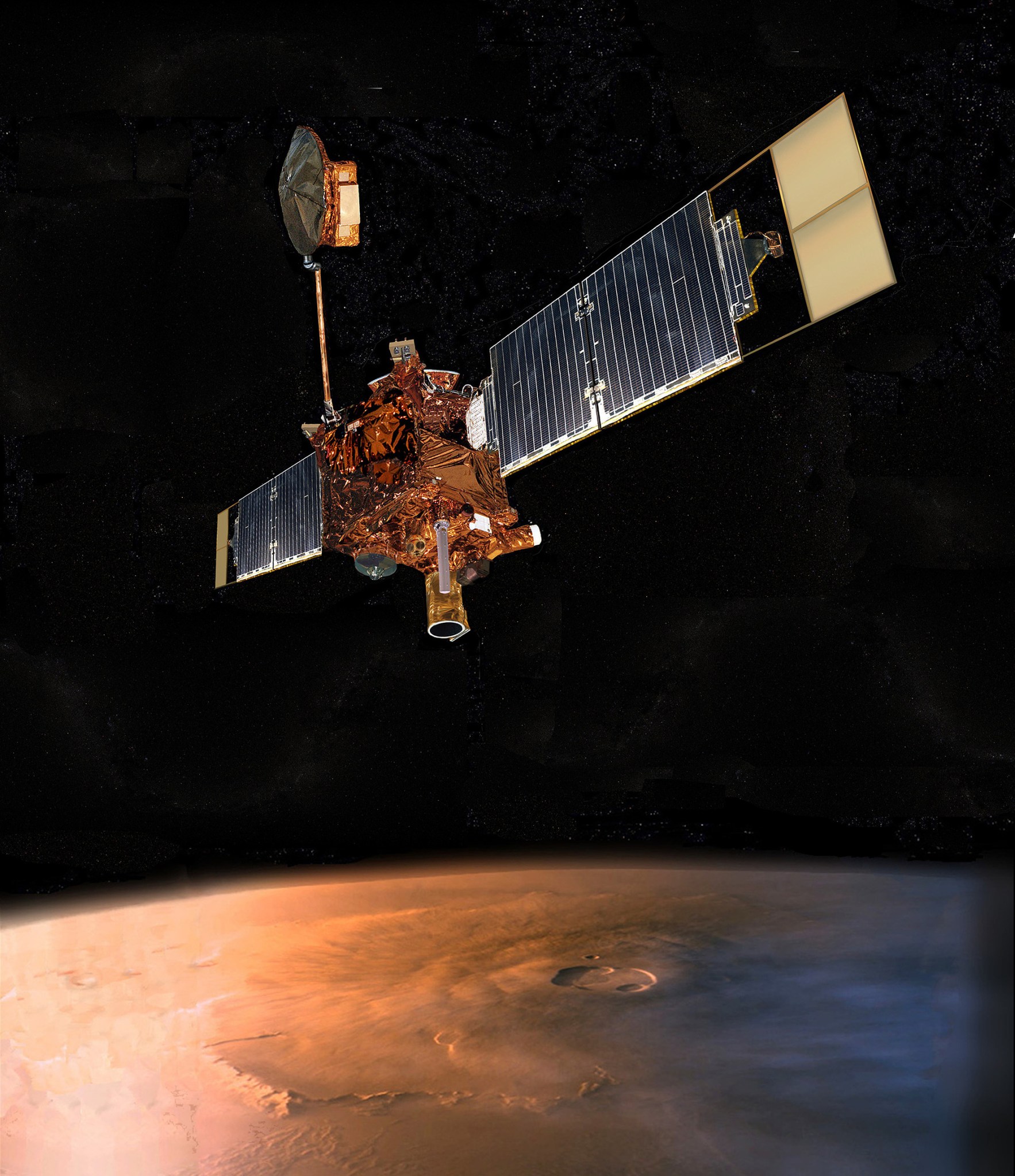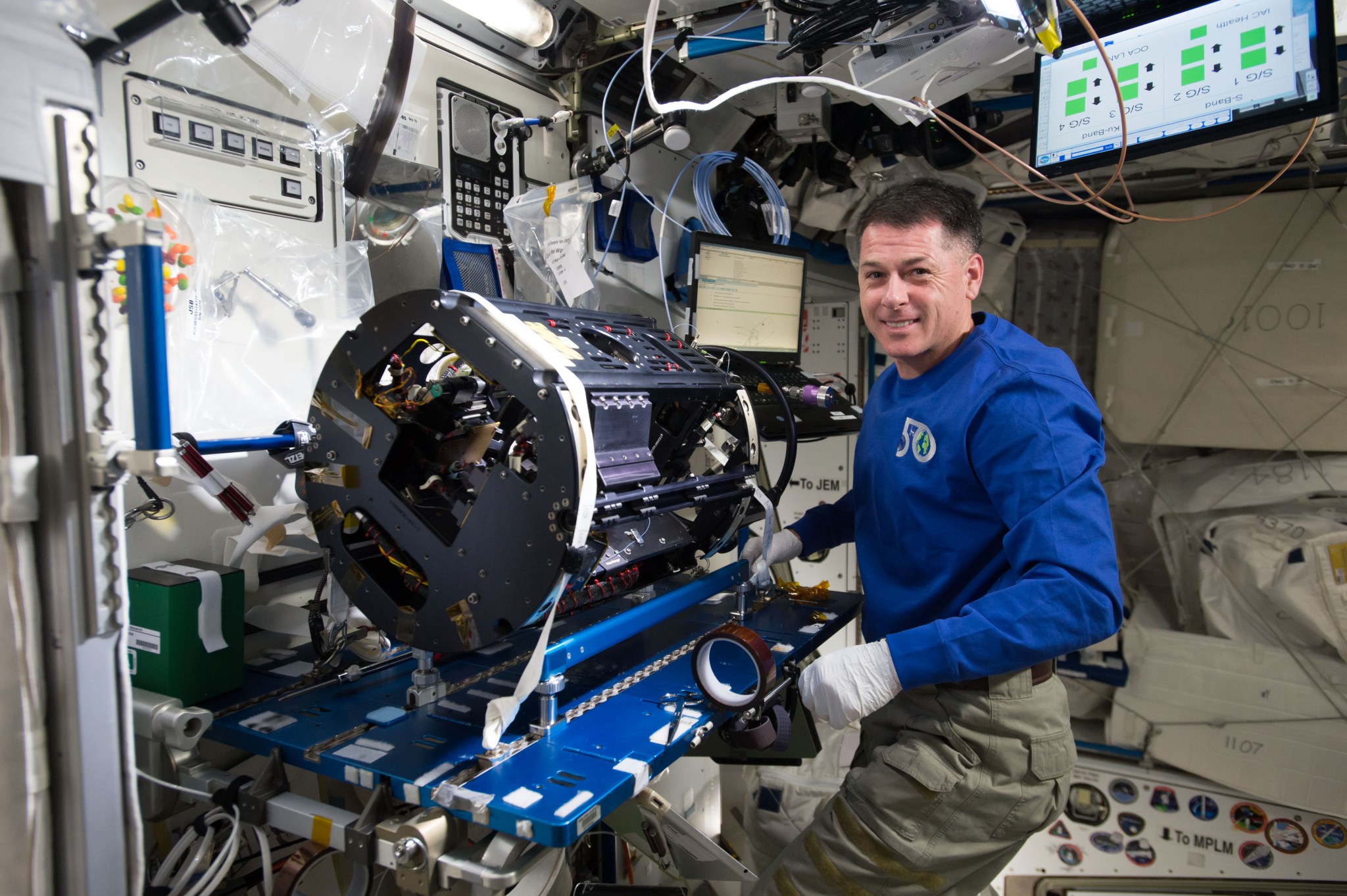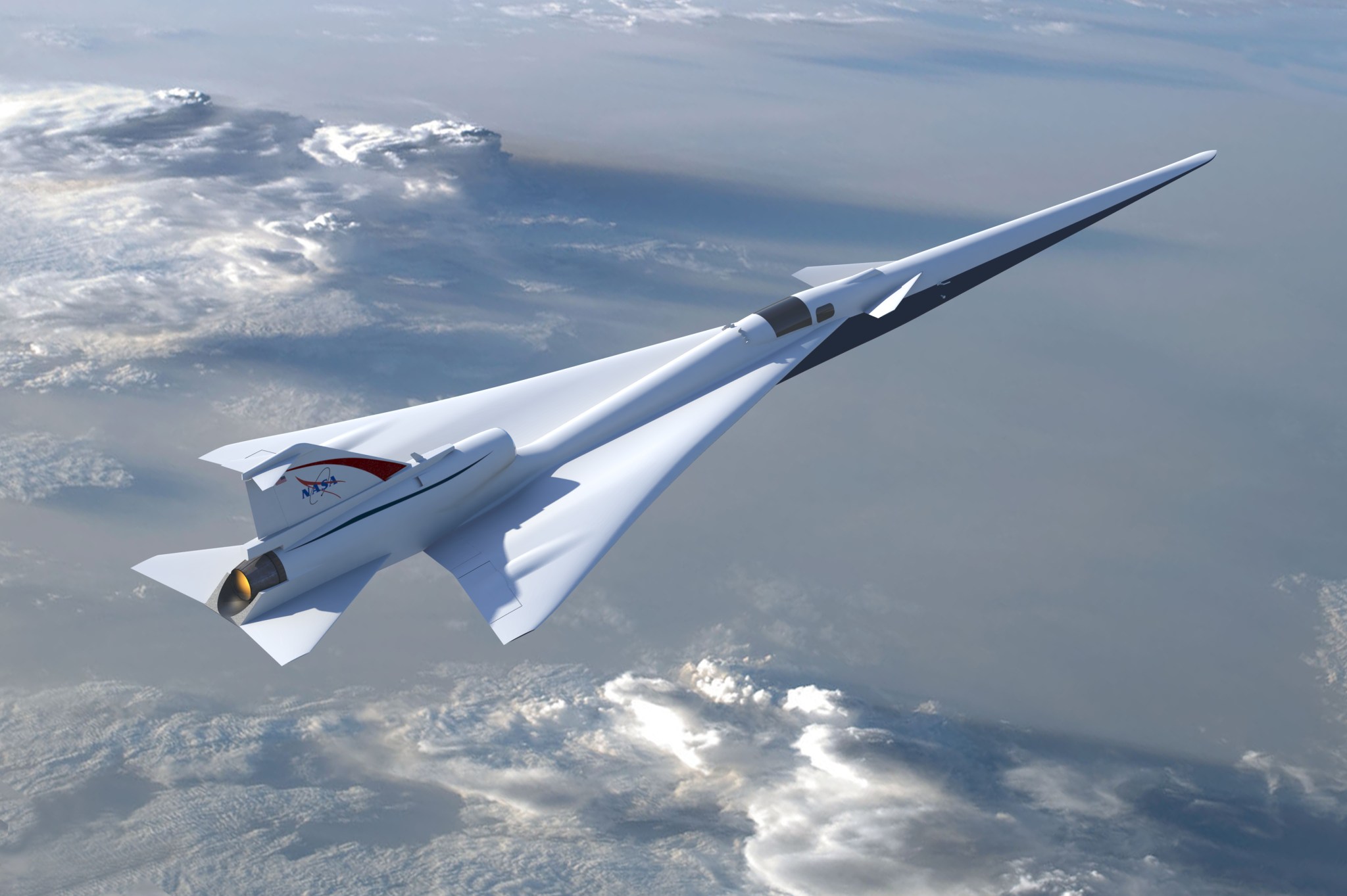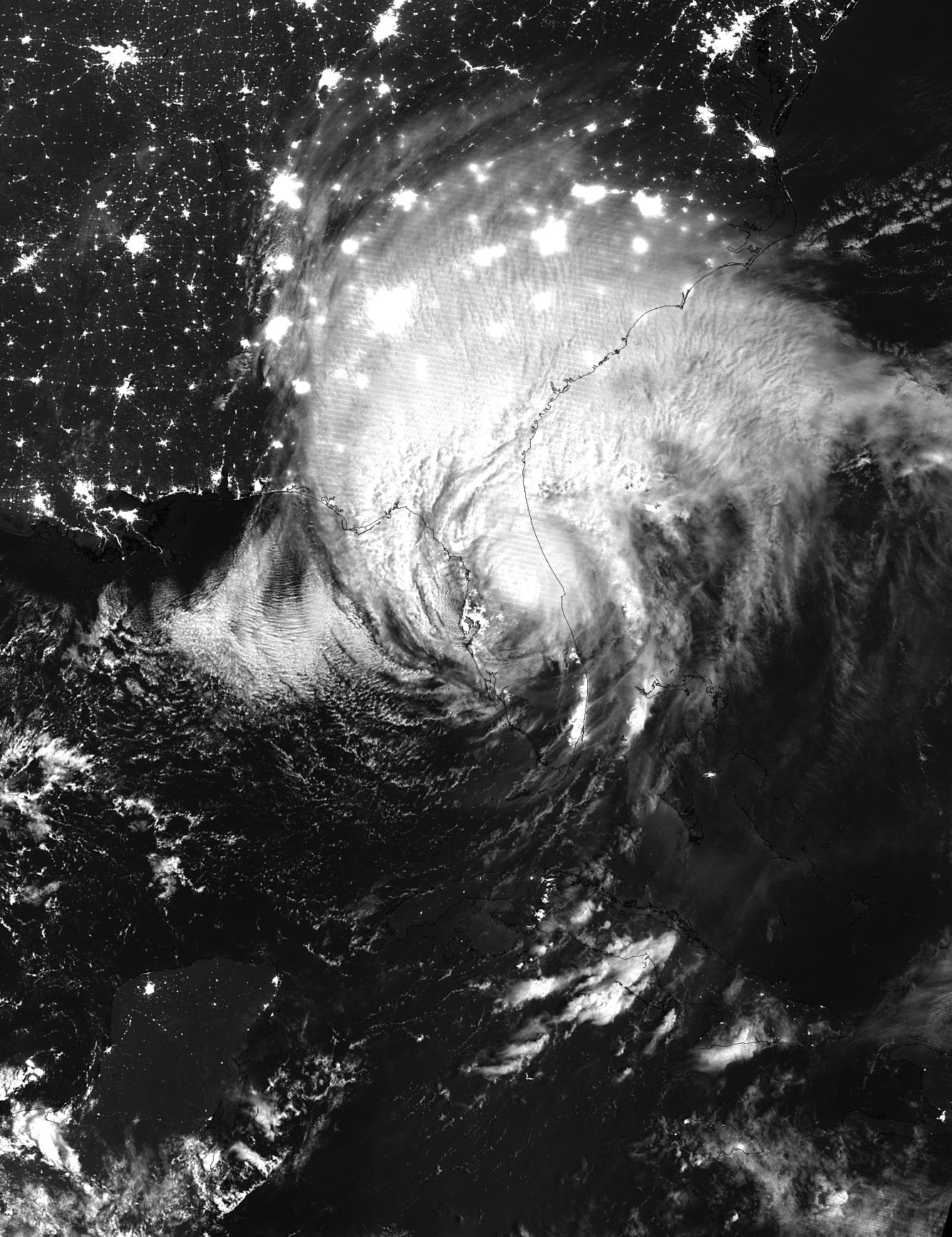The Moon became a key focus point for NASA in 2017, whether it was blocking out the Sun during one of the most-viewed events in U.S. history, or reinvigorating the agency’s human space exploration plans.
One of the numerous NASA-related activities and actions the Trump Administration did in 2017 was to reconstitute the National Space Council. During its first meeting on Oct. 5, Vice President Mike Pence directed NASA to develop a plan to help extend human exploration across our solar system, and return astronauts to the Moon in preparation for human missions to Mars and other destinations.
The White House’s support of NASA in 2017 extended across the breadth of the agency’s activities, including:
- President Trump signing the 2017 NASA Authorization Act in March
- The President calling the International Space Station from the Oval Office in April and U.S. record-setting NASA astronaut Peggy Whitson following her landing in September
- Vice President Pence visiting NASA’s Johnson Space Center in June, Kennedy Space Center in July, and Marshall Space Flight Center in September
- The Vice President seeing spacecraft preparations in October for NASA’s next mission that will land on the Red Planet: InSight
“When you see highlights of NASA’s achievements over the year listed in one place, it’s pretty amazing what we’ve been able to achieve,” said acting NASA Administrator Robert Lightfoot. “Seeing so many challenging efforts become completed accomplishments is a testament to the determination of our entire extended NASA team. While I’m proud of what we did in 2017, another full plate of missions awaits us in 2018 that will surely inspire with their discoveries and technological advances.
“And for the sixth year in a row, NASA has retained its standing as the number one large agency in the ‘Best Places to Work in Government’ rankings published by the Partnership for Public Service. I want to congratulate and commend our amazing workforce for their teamwork and dedication, which has enabled so many achievements in all our missions on behalf of the American people and the world.”
Solar System and Beyond
2017’s top story in terms of public interest for NASA was, by far, the Aug. 21 total solar eclipse. It was one of the biggest internet events in recent history and the biggest online event NASA has ever measured. There were more than 50 million views of the live broadcast on NASA.gov and multiple social media platforms, and almost 31 million unique views on Facebook before and after the eclipse. These numbers mean the agency was able to share the scientific study of this celestial phenomenon with millions of people around the world, capturing a wealth of images before, during, and after the eclipse by spacecraft, aircraft, high-altitude balloons, and astronauts aboard the International Space Station — seen in the image on the right as it orbited between the Earth and the Sun during the eclipse.
Here are some of this year’s other highlights in the solar system and beyond:
- A thrilling epoch in the exploration of our solar system came to a close Sept. 15, as NASA’s Cassini spacecraft made a fateful plunge into the atmosphere of Saturn, ending its 13-year tour of the ringed planet. The mission transformed our understanding of ocean worlds, where life may potentially exist beyond Earth.
- Humanity’s farthest and longest-lived space mission – NASA’s Voyager 1 and 2 – celebrated 40 years of unprecedented science findings and imagery on Sept. 5. NASA continues to communicate with the spacecraft daily as they explore the frontier where interstellar space begins.
- A spacecraft that will touch the Sun was named for a living researcher: Eugene N. Parker, professor emeritus at the University of Chicago. NASA’s Parker Solar Probe is scheduled for launch in 2018 to explore the Sun’s outer atmosphere.
- NASA’s Fermi Gamma-ray Space Telescope detected the first light ever tied to a gravitational-wave event, thanks to two merging neutron stars in the galaxy NGC 4993, located about 130 million light-years from Earth. NASA’s Swift, Hubble, Chandra and Spitzer missions, along with dozens of ground-based observatories, later captured the fading glow of the blast’s expanding debris.
- The James Webb Space Telescope completed environmental testing at NASA’s Goddard Space Flight Center and the Johnson Space Center as it readies for assembly into a single spacecraft ahead of launch in 2019.
- NASA’s Spitzer Space Telescope revealed the first known system of seven Earth-size planets around a single star, with three planets located in the habitable zone, the area around a star where a rocky planet is most likely to have liquid water.
- NASA’s Hubble Space Telescope found an exoplanet that snows sunscreen, but only on the side of the planet that permanently faces away from its host star.
- NASA’s Kepler space telescope team released its most comprehensive and detailed catalog of exoplanet candidates, introducing 219 new planet candidates, 10 of which are near-Earth size and orbiting in their star’s habitable zone.
- Astronomers using data from NASA’s Chandra X-Ray Observatory and other telescopes found evidence for a star that whips around a black hole about twice an hour, which could be the tightest orbital dance ever witnessed between a possible black hole and a companion star.
- NASA’s OSIRIS-REx asteroid sample return spacecraft successfully used Earth’s gravity on Sept. 22 to slingshot itself on a path toward the asteroid Bennu, for a rendezvous next summer. The spacecraft is on a seven-year journey to rendezvous with, study, and return a sample of Bennu to Earth.
- NASA selected two new planetary missions on Jan. 4 that have the potential to open new windows on one of the earliest eras in the history of our solar system. The Lucy mission will visit a target-rich environment of Jupiter’s mysterious Trojan asteroids, while the Psyche mission will study a unique metal asteroid that’s never been visited before.
- Early science results from NASA’s Juno mission to Jupiter portray the largest planet in our solar system as a complex, turbulent world, with Earth-sized polar cyclones and plunging storm systems that travel deep into the heart of the gas giant.
- On Oct. 19, the NASA-funded Pan-STARRS1 telescope discovered the first confirmed object to travel through our solar system from another star. The historic discovery revealed the interstellar interloper to be a rocky, cigar-shaped object with a ratio of length to width unlike any asteroid or comet observed in our solar system.
- An international team of astronomers led by NASA scientists successfully completed the first global exercise using a real asteroid – 2012 TC4 – to test global response capabilities. The exercise tested the International Asteroid Warning Network for hazardous asteroid observations, modeling, prediction and communication.
Mars
In 2017, NASA made progress in the preparations to send astronauts to Mars, as well as reaching the milestone of 20 years of continuous robotic scientific exploration of the Red Planet. And a record 2.4 million space fans signed up this year to send their names to Mars on NASA’s InSight mission, a robotic lander designed to study the interior and subsurface of the planet in 2018.
- On Nov. 16, NASA selected a science instrument for an upcoming sample return mission to the moons of Mars: a Japan-led mission known as MMX to the moons of Mars. The instrument will help scientists resolve questions about when and how the small moons formed around the Red Planet.
- After receiving a record-breaking number of applications to join an exciting future of space exploration, NASA selected on June 12 women and men as the agency’s new astronaut candidates. They may fly on future deep space missions using the world’s most powerful rocket, the Space Launch System (SLS), and the Orion spacecraft. This year, NASA has been building and testing hardware for both the first and second missions for SLS and Orion.
Here are some of this year’s highlights about progress toward human deep space missions to the Moon and Mars:
- The first piece of completed SLS hardware for the first test mission, Exploration Mission-1, was delivered to Kennedy Space Center for processing.
- Flight preparations are complete for the four liquid fuel engines that will help power SLS on its first mission, and engineers began testing engines for the second mission that will carry crew, Exploration Mission-2.
- All five parts of the rocket’s core stage are built and ready for additional outfitting and testing.
- The 10 motor segments have been cast for the two solid rocket boosters, and they are on track to be ready for the first integrated test flight.
- NASA has moved up a critical crew safety launch abort test for the Orion spacecraft in advance of the first launch with humans, and teams also have been testing the parachutes to bring the capsule to a safe landing as well as exit procedures for the crew after returning from a mission.
- Meanwhile, teams powered on the Orion spacecraft for the first integrated test launch, and are busy building the Orion capsule for the first crewed mission.
- At the future launch site for SLS and Orion, upgrades to the walls of the flame trench are complete as well as the installation of all the work platforms in the Vehicle Assembly Building where the rocket will be stacked prior to launch.
- The agency began studying the deep space gateway concept with U.S. industry and space station partners. Using the most powerful rocket in the world, NASA would launch a power and propulsion element, habitation module for crew, and logistics module for the gateway concept in the early crewed missions of SLS and Orion.
- NASA continues to use its Next Space Technologies for Exploration Partnerships (NextSTEP) public-private partnership model to seek commercial development of deep space exploration capabilities. This year, NASA is seeking proposals for development of a first-generation, in-space, multi-material fabrication laboratory, or FabLab, for space missions; selected five companies for studies for the gateway power and propulsion element; announced it will seek proposals for research contracts in In Situ Resource Utilization (ISRU) Technology; and its partners are developing prototypes of habitat structures.
- NASA engaged the public in many citizen challenges, including the Space Poop challenge, which awarded winners for proposed solutions to address how to collect and route human waste away from the body, if an astronaut were wearing a spacesuit in microgravity for up to six days.
International Space Station
In 2017, six NASA astronauts have lived aboard the International Space Station, supporting more than 120 new U.S. research investigations conducted in the unique microgravity laboratory to prepare for future deep space exploration and improve life on Earth. Investigations included research leading to new knowledge about combustion processes, tests of a drug to help fight cancer, and technology demonstrations like the Bigelow Expandable Activity Module (BEAM). In addition, the space station hosts many external experiments that observe Earth and our environment from space and study space physics, such as neutron stars, black holes, and the search for dark matter. More than 170 total U.S. investigations this year are advancing our understanding in biology and biotechnology, physical sciences, human research, technology development and education.
Here are some additional space station highlights from 2017:
- The arrival of the Expedition 53 crew marked the first long-term increase in crew size on the U.S. segment from three to four, allowing NASA to maximize time dedicated to research.
- Peggy Whitson broke multiple records during an extended mission to the station, becoming the U.S. astronaut who has spent the most total time in space, tallying 665 days during three missions.
- During nine spacewalks, NASA astronauts’ work prepared for the arrival of future commercial crew spacecraft and upgraded the station’s capabilities.
- During five missions in 2017, NASA’s commercial cargo partners Orbital ATK and SpaceX launched more than 32,900 pounds of critical supplies to the International Space Station, including crew supplies and equipment to support the hundreds of crucial science experiments and technology demonstrations aboard the space station. With its splashdown in the Pacific Ocean following three resupply missions, the SpaceX Dragon capsule also returned more than 13,000 pounds of research and equipment.
- NASA advanced its goal to once again launch astronauts from Florida’s Space Coast to the International Space station as Commercial Crew Program providers Boeing and SpaceX made progress on the Starliner and Crew Dragon spacecraft and systems, respectively. Boeing revealed its spacesuit design early in the year and conducted important parachute and qualification tests. SpaceX also unveiled its spacesuit, and worked with NASA and the Air Force to refine its procedures to retrieve astronauts from the water following a mission to the space station.
- Sierra Nevada Corporation successfully completed a free-flight test of its Dream Chaser spacecraft, meeting the final milestone of a space act agreement for the Commercial Crew Program. The test also supported a milestone in preparation to carry cargo and science investigations to the space station under the agency’s next generation commercial resupply services contracts.
- The space station continues to be used to inspire future generations with a special focus for a Year of Education on Station with astronauts and former classroom teachers Joe Acaba and Ricky Arnold, and their crewmates.
- NASA’s space communications and navigation capabilities were upgraded with the August launch of the Space Network’s Tracking and Data Relay Satellite-M (TDRS-M), the third and final in the Space Network’s space system that provides near-constant communication links to Earth from the International Space Station, the Hubble Space Telescope, and many other missions.
- The station also helped advance technology needed to enable human exploration of deep space: the in-orbit characterization of Phase Change Heat Material Heat Exchangers was completed to provide better temperature regulation for Orion and future deep space vehicles.
Aeronautics
Safely moving increasing numbers of people and cargo more efficiently between airports aboard airplanes of all sizes, which burn less fuel, release fewer emissions, and fly both quieter and faster, remained the focus of NASA’s aeronautical innovators as they achieved several technical milestones in 2017. Some of those milestones are laying the foundation for the return of the X-plane to NASA’s research toolbox.
Here are some research highlights realized in 2017 that herald NASA’s great aviation transformation:
- NASA-developed systems to help air traffic managers and pilots more efficiently fly from departure gate to arrival gate were demonstrated: the first near Seattle early in the year and the second at Charlotte Douglas International Airport beginning in September.
- Enabling commercial supersonic passenger jet travel over land is a key goal for NASA aeronautics. A preliminary design for just such an aircraft was completed in June after wind tunnel tests in Ohio and Virginia, and information that will help quiet sonic booms was gathered during flight tests in Florida in August.
- The explosive demand for Unmanned Aerial Systems, or drones, has prompted NASA to take the lead in assisting government and industry in finding the safest, most efficient ways to integrate these new aircraft into the airspace above us.
- Testing flexible wings, reducing noise from landing gear, improving the odds of surviving a crash, improving research methods with optical fiber, and deploying new hardware to better test helicopters are among the many other projects that saw results in 2017.
- NASA aeronautics in 2017 also showcased its most important resource – people – by introducing a new university leadership initiative, funding a trio of potentially transformative research teams, and celebrating honors and accomplishments.
- One of the NASA centers that does a great deal of aeronautic research, Langley Research Center in Hampton, Virginia, celebrated its 100th anniversary this year.
Earth
In 2017, NASA further used the vantage point of space to increase our understanding of our home planet, improve lives, and safeguard our future. The 60th anniversary of space-based research of Earth, and the beginning of the United States’ exploration of space, comes in January 2018, followed by NASA’s 60th birthday on Oct. 1.
Here are some highlights from this year in NASA’s Earth sciences research:
- A new NASA study provided space-based evidence that Earth’s tropical regions were the cause of the largest annual increases in atmospheric carbon dioxide concentration seen in at least 2,000 years. The research used global data from NASA’s Orbiting Carbon Observatory-2, launched in 2014.
- NASA’s program to turn Earth science data from space into life- and property-saving information when natural disasters strike on Earth contributed to major hurricane, earthquake, and wildfire response efforts in 2017.
- NASA Earth satellite data revealed the formation of a massive iceberg the size of the state of Delaware that split off the Larsen C ice shelf in Antarctica in July.
- NASA’s use of the International Space Station for scientific studies of Earth continued to grow with the launch of instruments to observe lightning and the protective ozone layer in February and another in December to track the Sun’s influence on our climate.
- Scientists created the first global inventory of sulfur dioxide emissions from volcanoes using over a decade of data from NASA’s Aura satellite. Sulfur dioxide is a harmful air pollutant and a contributor to climate change.
Technology
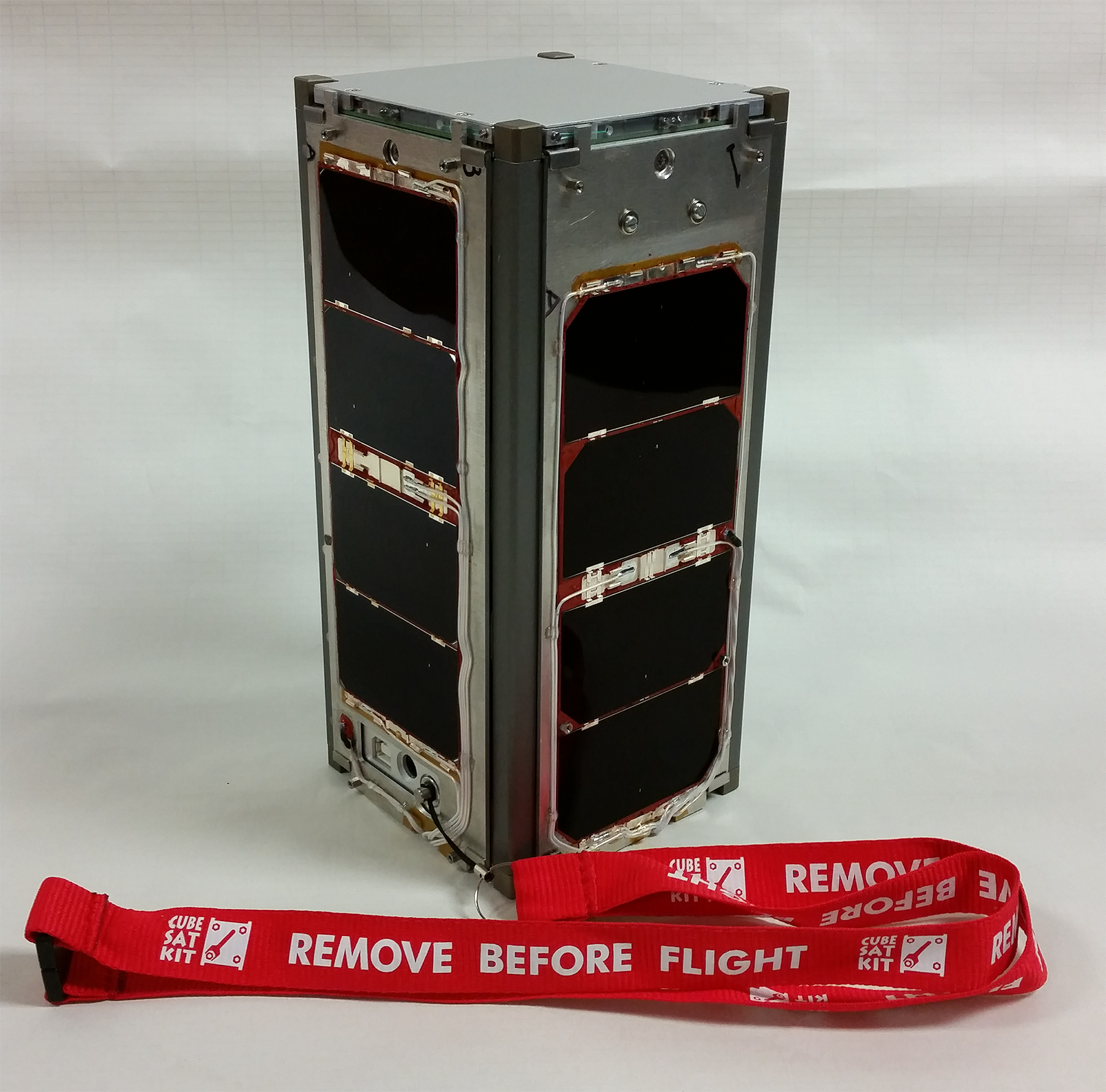
This year, NASA’s investments in space technology paid off with the launch of several technology payloads delivered to the International Space Station and beyond, the completion of two big-prize competitions, and the ground-based demonstration of technologies that may one day build and repair large structures in space.
Here are some of NASA’s technology highlights for 2017:
- The Station Explorer for X-ray Timing and Navigation Technology (SEXTANT,) will test – for the first time in space – the use of pulsars to form a GPS-like system that can support spacecraft navigation throughout the solar system, enabling deep space exploration in the future. SEXTANT, included with the Neutron Star Interior Composition Explorer (NICER), now is operating from the exterior of the space station.
- On Nov. 12, two small spacecraft missions, which launched aboard the Orbital ATK CRS-8 Cygnus resupply mission to the International Space Station, will test the high-speed optical transmission of data and small spacecraft proximity operations, and demonstrate a reflect array antenna that increases downlink data rates for CubeSats.
- Since NASA’s Centennial Challenges began in 2005, there have been 18 challenges, resulting in more than $8 million in prize money awarded to more than 60 teams from across the country.
- In August, Team Foster + Partners of Chattanooga, Tennessee won first place and a prize of $250,000 for successfully completing Phase 2, Level 3 of the 3D-Printed Habitat Challenge.
- The Space Technology Mission Directorate’s Cube Quest Challenge awarded $20,000 each in prize money and secured space to launch the three winning teams’ CubeSats on Exploration Mission-1, the first integrated flight of NASA’s Space Launch System and Orion spacecraft.
- Centennial Challenges’ active competitions are: the Vascular Tissue Challenge to advance the field of tissue engineering; Cube Quest to advance the capabilities of small satellite technology; and Phase 3 of the 3D-Printed Habitat Challenge to advance the construction technology needed to create sustainable housing solutions for Earth and beyond.
- NASA and its commercial partners are well on their way to demonstrating technologies that can manufacture, assemble and repair large structures in space through the In-space Robotic Manufacturing and Assembly (IRMA) projects.
Public Engagement
- By engaging in public events, including South by Southwest; Philadelphia Science Festival; Space Day; Artscape; EAA AirVenture; Albuquerque Balloon Festival; Consumer Electronics Show; Super Bowl LI, Bay Area Science Festival; OshKosh; Essence Festival; Boy Scout Jamboree; Intrepid; and the Chicago Air & Water Show, more than five million people had the chance to interact with representatives of America’s space agency.
- NASA’s social media presence continued to grow in 2017 with more than 130 million total followers across all accounts and platforms. The agency has the most followers of any agency/department in the federal government on Facebook, Instagram, Twitter, Snapchat and Google+. The agency also hosted 13 NASA Socials this year, bringing together more than 650 followers who engage with NASA via social media for unique in-person experiences of exploration and discovery.
- NASA’s digital communications team was honored with four Webby Awards in 2017. For the first time, NASA’s social media presence was recognized by the Webby Awards, winning in corporate communications and being honored with the People’s Voice Award. NASA’s Cassini project was recognized with its second Webby for science websites. NASA.gov, the agency’s primary website, received its ninth People’s Voice Award in the Government & Civil Innovation category. The total solar eclipse drove unprecedented traffic to NASA.gov, with a record 25.8 million visits on Aug. 21. Overall this year, traffic rose 24 percent over 2016 to just more than 410,000 visits daily.
For more about NASA’s missions, research and discoveries, visit:
-end-
Jen Rae Wang / Allard Beutel
Headquarters, Washington
202-358-1600
jenrae.wang@nasa.gov / allard.beutel@nasa.gov


























